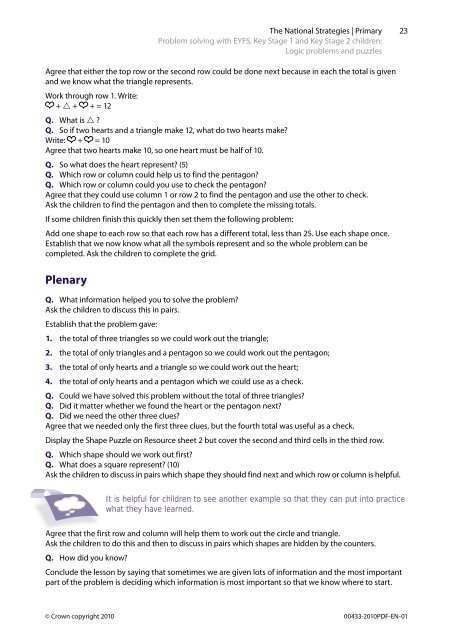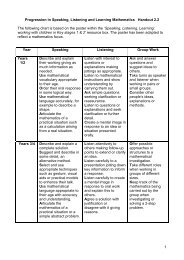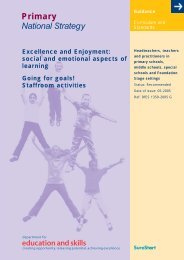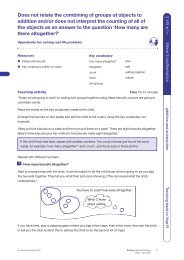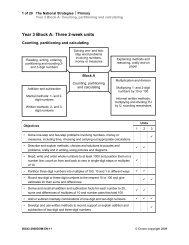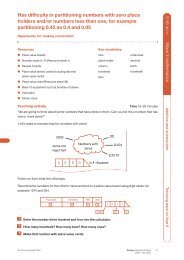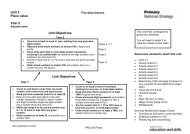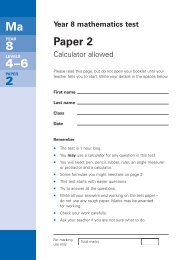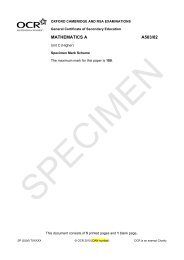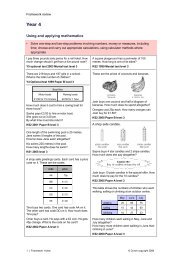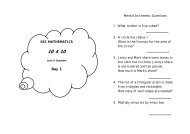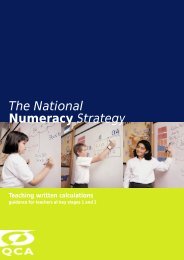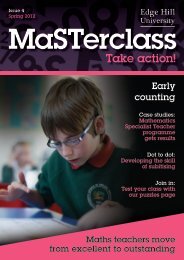Problem solving with EYFS, Key Stage 1 and Key Stage 2 children ...
Problem solving with EYFS, Key Stage 1 and Key Stage 2 children ...
Problem solving with EYFS, Key Stage 1 and Key Stage 2 children ...
You also want an ePaper? Increase the reach of your titles
YUMPU automatically turns print PDFs into web optimized ePapers that Google loves.
The National Strategies | Primary<br />
<strong>Problem</strong> <strong>solving</strong> <strong>with</strong> <strong>EYFS</strong>, <strong>Key</strong> <strong>Stage</strong> 1 <strong>and</strong> <strong>Key</strong> <strong>Stage</strong> 2 <strong>children</strong>:<br />
Logic problems <strong>and</strong> puzzles<br />
23<br />
Agree that either the top row or the second row could be done next because in each the total is given<br />
<strong>and</strong> we know what the triangle represents.<br />
Work through row 1. Write:<br />
+ + + = 12<br />
Q. What is ?<br />
Q. So if two hearts <strong>and</strong> a triangle make 12, what do two hearts make?<br />
Write: + = 10<br />
Agree that two hearts make 10, so one heart must be half of 10.<br />
Q. So what does the heart represent? (5)<br />
Q. Which row or column could help us to find the pentagon?<br />
Q. Which row or column could you use to check the pentagon?<br />
Agree that they could use column 1 or row 2 to find the pentagon <strong>and</strong> use the other to check.<br />
Ask the <strong>children</strong> to find the pentagon <strong>and</strong> then to complete the missing totals.<br />
If some <strong>children</strong> finish this quickly then set them the following problem:<br />
Add one shape to each row so that each row has a different total, less than 25. Use each shape once.<br />
Establish that we now know what all the symbols represent <strong>and</strong> so the whole problem can be<br />
completed. Ask the <strong>children</strong> to complete the grid.<br />
Plenary<br />
Q. What information helped you to solve the problem?<br />
Ask the <strong>children</strong> to discuss this in pairs.<br />
Establish that the problem gave:<br />
1. the total of three triangles so we could work out the triangle;<br />
2. the total of only triangles <strong>and</strong> a pentagon so we could work out the pentagon;<br />
3. the total of only hearts <strong>and</strong> a triangle so we could work out the heart;<br />
4. the total of only hearts <strong>and</strong> a pentagon which we could use as a check.<br />
Q. Could we have solved this problem <strong>with</strong>out the total of three triangles?<br />
Q. Did it matter whether we found the heart or the pentagon next?<br />
Q. Did we need the other three clues?<br />
Agree that we needed only the first three clues, but the fourth total was useful as a check.<br />
Display the Shape Puzzle on Resource sheet 2 but cover the second <strong>and</strong> third cells in the third row.<br />
Q. Which shape should we work out first?<br />
Q. What does a square represent? (10)<br />
Ask the <strong>children</strong> to discuss in pairs which shape they should find next <strong>and</strong> which row or column is helpful.<br />
It is helpful for <strong>children</strong> to see another example so that they can put into practice<br />
what they have learned.<br />
Agree that the first row <strong>and</strong> column will help them to work out the circle <strong>and</strong> triangle.<br />
Ask the <strong>children</strong> to do this <strong>and</strong> then to discuss in pairs which shapes are hidden by the counters.<br />
Q. How did you know?<br />
Conclude the lesson by saying that sometimes we are given lots of information <strong>and</strong> the most important<br />
part of the problem is deciding which information is most important so that we know where to start.<br />
© Crown copyright 2010 00433-2010PDF-EN-01


